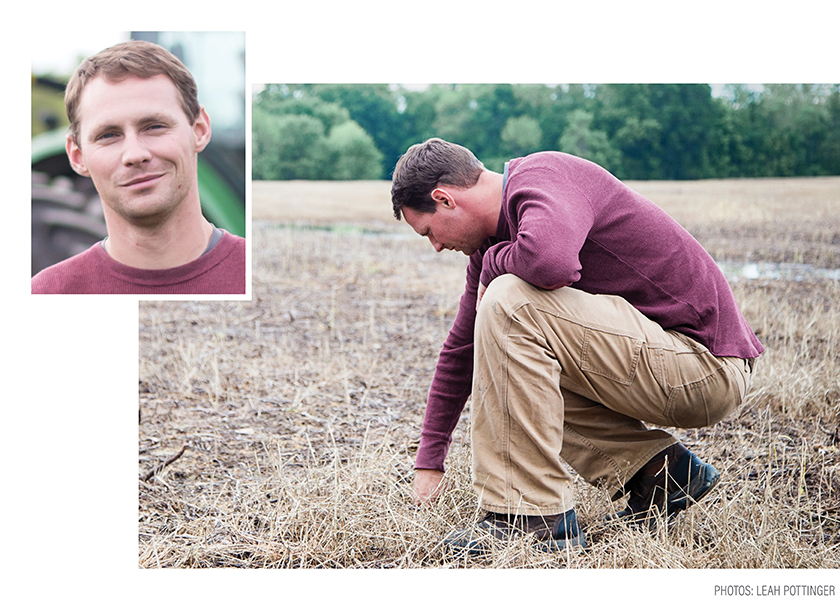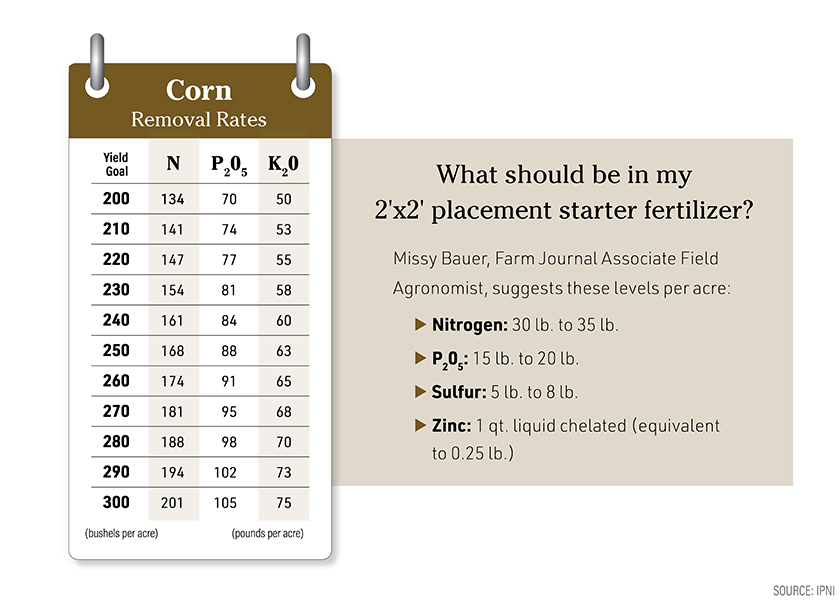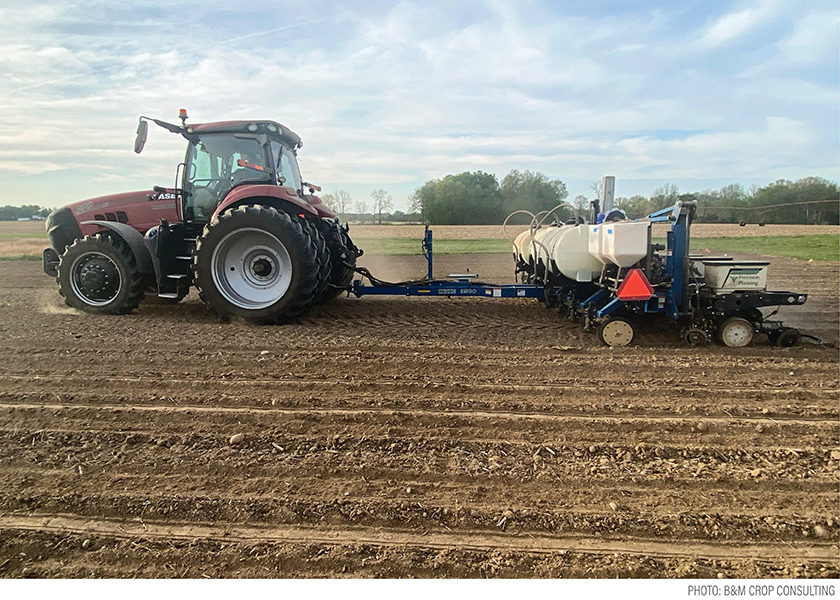Make Every Pass Count

Play the long game; draw up a plan that pays
On an early January morning, Quint Pottinger is contemplating changing his 2022 corn fertility program for the third time in as many months.
“We had it figured out in November, then changed it in December and we’re probably going to change it again,” says Pottinger, owner of Affinity Farms near New Haven, Ky. “All of our recent fertility estimates are at least double what they were this time last year. We’re evaluating every field and within every field to decide what we’re going to do.”
Scenarios similar to Pottinger’s are playing out across corn country, as farmers grapple with high input prices and concerns whether they can even source sufficient nitrogen (N), phosphorus (P) and potassium (K).
Pottinger’s goal is to get his N, P and K costs back in line with margins based on commodity prices but not sacrifice corn yields in the process. If prices continue to escalate, he plans to make fertilizer applications that achieve the best cost-benefit ratio in each field.
“I never thought I‘d say this, but in a high-price environment, we‘re looking at negative 20% margins versus back when corn was $3.80 to $4, our margins were positive 20% to 30%,” he says.

WHERE TO START
Blanket rates of N, P and K are easy to calculate but costly. To make every pass in the field count agronomically and financially, start by harnessing the four Rs — right source, right rate, right time and right place — advises Ken Ferrie, Farm Journal Field Agronomist.
Use a nutrient plan based on soil test results in tandem with an itemized budget to make fertility decisions.
“That combination equips you to fine-tune decisions based on hard facts and not guesswork, so you aren’t winging it,” Ferrie says.
Develop an input budget and work with your suppliers to make it a reality. “You can tell your retailer, ‘Here‘s my cost of inputs and my soil tests. Here are the dollars I have to spend this season. Based on my budget, how can I invest these dollars most effectively?’” he says.
One caution: Don’t cut limestone from your budget. “Balanced pH can do wonders for nutrient availability, so maintain limestone,” says Missy Bauer, Farm Journal Field Agronomist. “It should be one of the last things you choose to cut.”
HARD REALITIES DRIVE DECISIONS
Garrett Riekhof is watching every penny on his Lafayette County, Mo., farm.
“We are tracking input costs extremely close,” he says. “Those inputs that are a bit more discretionary we are having to justify.”
Riekhof soil tests ahead of corn acres every year to refine N, P and K rates to determine where to place nutrients and how much.
“Our fields are so darn variable,” he says. “Some years they require a little extra N, and other years those same fields require a little less, depending on the mineralization. Often, the total pounds of N stays the same; I’m just reallocating N placement and timing.”
If you don’t have a fertility plan based on soil tests, using nutrient removal rates (specifically for P and K) is another — though less effective — strategy when strapped for dollars or access to nutrients, Ferrie says.
This practice requires you to know the amount of P and K a crop pulls from your soils, so you can replace them. The idea is to establish a fertility baseline that can be fine-tuned.
“First, calculate how many bushels of corn it will take to pay for full product rates,” Ferrie says. “Then decide where you want to go from there with rates based on product availability and return on investment.”
Your retailer or agronomist is the best resource for nutrient removal rates in your area. In a pinch, you can use an online resource such as the International Plant Nutrition Institute (IPNI) for ballpark numbers. IPNI data shows with a 200-bu. corn crop to expect removal rates of around 70 lb. of P205 and 50 lb. of K20 per acre.
If you haven’t used variable-rate technology before, this is the year to start, Ferrie adds.
“If you lack the technology to change fertilizer rates in-field, on the fly, consider how you can make adjustments by field or within areas of each field,” he says.
AVOID THIS MISTAKE
If you fall-applied anhydrous ammonia (NH3) to fuel all of your 2022 corn crop, you could be in trouble. Corn roots don’t reach NH3 until at least V6, Ferrie says. By then, you will have lost substantial yield potential with no chance to get it back.
Applying N with the planter this spring would be a good match up with fall-applied NH3, he adds.
“Our research shows 30 lb. of N applied in a 2'x2'-type placement will do as much to get that young corn plant out of the ground and growing as 60 lb. broadcast,” Ferrie says.
Along with the 30 lb. of N in the 2'x2', Bauer says to include 15 lb. to 20 lb. of P205, 5 lb. to 8 lb. of sulfur and 1 qt. of liquid chelated zinc equivalent to 0.25 lb. of actual zinc. “Putting these nutrients on with the planter can help corn get a strong start in what are typically cool, wet conditions,” she says.
EVALUATE POPULATIONS
Ferrie says to analyze corn seeding populations to determine if you can lower them without sacrificing yield goals. Reducing seeding rates can help take some pressure off N, P and K to fuel the crop — especially if you reduced rates.
Pottinger currently plants 31,000 to 33,000 seeds per acre to reach a 200-bu. dryland yield average and anticipates tweaking those numbers based on his fertility program.
“We know we can push seeding rates down a bit, but we can’t go at it too hard because we run the risk of reducing our ear count and missing our yield goal,” he says.
Ferrie recommends you sit down with your past yield data and topography maps to break fields into population zones.

PLAN IN-SEASON DECISIONS
There is little you can do if fertilizer supplies evaporate or prices go beyond what your budget can tolerate.
“Think through several nutrient scenarios, stay in touch with your farm advisers and be prepared to act as the season unfolds,” Ferrie says.
If N pencils out, consider what the corn crop needs in-season to reach optimum yields at harvest.
From V8 to tasseling, for example, corn plants use between 7 lb. and 10 lb. of N per day. The amount of N available at this point is as important as the placement.
“Even a soil with the ability to mineralize high amounts of N will not be able to keep up or be able to mineralize enough on a per-day basis to meet the crop needs in that rapid growth,” he says.
From tasseling to black layer, most hybrids need about 120 lb. of N. That's only about 2 lb. per day and is important for kernel depth and high test weights.
Throughout the growing season, watch your weather conditions and monitor soil nitrate levels, Ferrie says. Course-correct with N when tests dictate it.
“Keep in mind when you’re dealing with nutrients that affect yield, N is the big dog. When you run out, yields will drop,” he cautions. “Missing P and K will change soil-test values but missing out on nitrogen reduces yields.”

Rhonda Brooks leverages 35 years of experience and farm roots to report on seeds and agronomy and serves as editor of Bovine Veterinarian.







